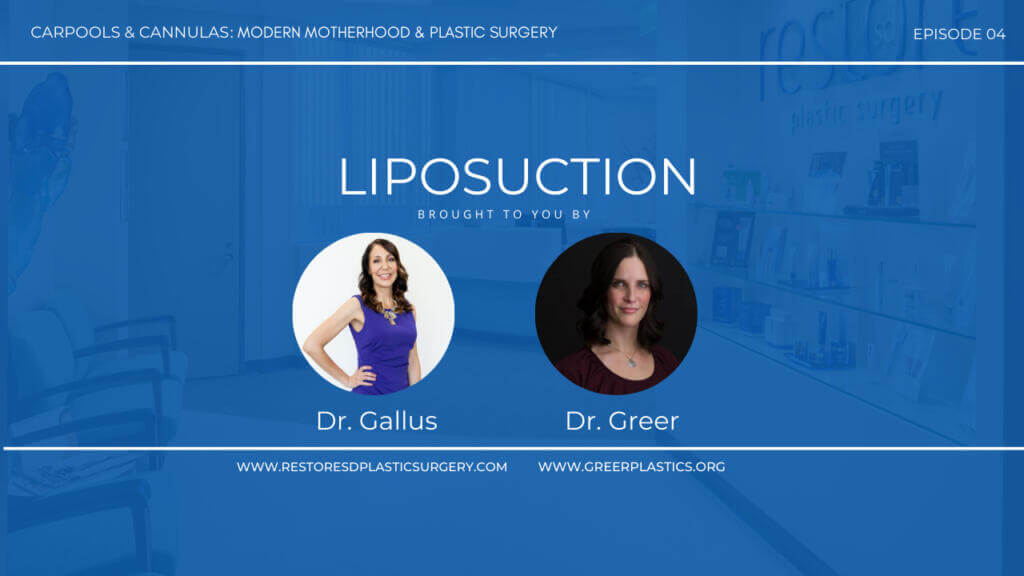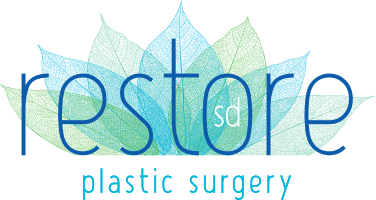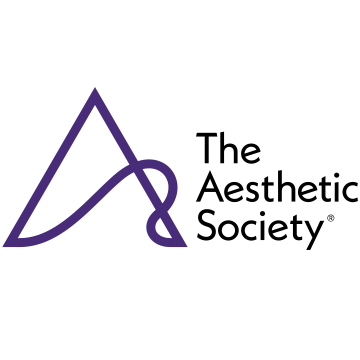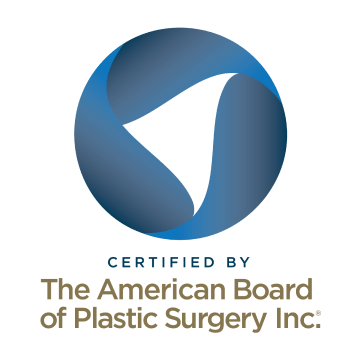About the Episode
Drs. Gallus and Greer finally get around to talking about the “cannula” part of our name! In this episode of Carpools & Cannulas: Modern Motherhood and Plastic Surgery, they break down liposuction – who is a candidate and what you need to know if you are thinking about having it.
Transcript
Dr. Greer: Hello, everyone. I hope you can join me tonight. Dr. Gallus will be on momentarily and we’re gonna be talking about liposuction, which I love. Not only do I do a lot of liposuction, but I’ve had liposuction, so I can talk about it from both sides. All right. There is Dr. Gallus. Let me pull her on. I’m trying to pull her on. There we go. Hey.
Dr. Gallus: Connecting. Mine says connecting. So, hopefully, I can see you in a second. Oh, there I am, cool.
Dr. Greer: Hi.
Dr. Gallus: Hi. How’s it going?
Dr. Greer: Oh, living the dream. Got the kids in bed, so if we hear the pitter-patter of little feet followed by screaming and barking, it’s cool.
Dr. Gallus: Oh, okay. Yeah, my kids are not in bed because it’s 5:30, but I have the weird emoji pillow behind me. So, that’s nice. It’s my daughter’s.
Dr. Greer: That’s nice. I had to…there’s…if you look further just off-screen, there’s a giant stack of Transformers that I just shoved over and replaced with a plant, so it looks very zen and professional.
Dr. Gallus: Yeah. So, that’s cool. Yeah, I always forget you’re so much farther ahead of me in time, but…
Dr. Greer: Yeah, three hours. I know, all those where you and Dr. Horton are, like, still at work. I’m like, “I might be in pajamas from the waist down.” It’s entirely possible.
Dr. Gallus: Yeah, yeah. No, I get that. Yeah. It’s always…and then for ASPS, for a national society, oftentimes they’re like, “Can you do it at 3:00?” And I’m like, “No. I know it’s 6:00 for you guys, but I really can’t have any…”
Dr. Greer: It’s, like, the middle of your day. Yeah.
Dr. Gallus: Mm-hmm. Yeah. And the couple of times I’ve tried it it’s been a mess. So…
Dr. Greer: Yeah. There’s still stuff happening. I don’t know how your office is, but I’m literally asked a question every five minutes. Yeah.
Dr. Gallus: Yeah. Totally.
Dr. Greer: And then they come in, they’re like, “Oh, you’re on video.” Backpedal.
Dr. Gallus: I know. So, this is what they ask.
Dr. Greer: Or they text you and you’re like, “I can’t text you back, I’m literally on my phone.”
Dr. Gallus: Exactly.
Dr. Greer: It’s good to be needed, though. I’m glad.
Dr. Gallus: Yeah. It keeps me off the streets, I always say.
Dr. Greer: Yeah.
Dr. Gallus: So, we were gonna talk about liposuction this week, which I think is a great topic.
Dr. Greer: I love liposuction. It is, I mean…okay, it’s one of those procedures that, like, it’s kind of like going to the gym. During the surgery, it’s maybe not as fun as other things because it’s just a lot of physical labor, but the end result is so worth it.
Dr. Gallus: That’s true. I’ve never heard it described that way. Yeah. I should start explaining it like that because I do think one of the common, like, not complaints, but one of the common things people discover after liposuction surgery, in the first couple of days, they’re like, “That really hurts,” or “It’s a little painful.”
Dr. Greer: It’s kind of like you did all those workouts.
Dr. Gallus: Yeah. Like, it is surgery. So, I try to warn people, but a lot of times they add it on to a different procedure, and they think, “Oh, it’s just liposuction.” I’m like, “No, you might actually, you know, find that’s more uncomfortable than the breast surgery, or something else you did.”
Dr. Greer: Oh, yeah.
Dr. Gallus: It’s for real.
Dr. Greer: Well, I did lipo on all my breast reductions, and that is hands-down always the more sore sport, where I lipoed…
Dr. Gallus: Oh, yeah. Right on the side?
Dr. Greer: Oh, hi Cleveland Downtown. We’re being followed by one of the Cleveland accounts tonight. Thanks for watching.
Dr. Gallus: Oh, cool. Yes. You guys are in for a treat.
Dr. Greer: Yeah. Although, I have to be totally straight-up about post-op pain and everybody’s different. Everybody experiences a different pain. I had lipo between kids two and three, so when was that, 2016, 2017? And I had it on a Monday, and I was back in the OR doing lipo on Thursday. Like, it was not…and that’s literally the only surgery I’ve had, but I think I took, like, one Norco that night to sleep, and then I took Motrin and I was like, “This is cool.” It was not awful.
Dr. Gallus: I know. I try not to use…I haven’t had it, but I try not to use myself as a barometer because I have a very high pain tolerance and tend not to give myself a break. But our office coordinator had it done, and she had it, I think, on a Friday and came back to work on a Monday. But…
Dr. Greer: Yeah. It depends. Although the other thing I’ve noticed with my patients is that the more fat I remove, the more sore they are. So, I always reassure them. I’m like, “That’s good. I took a lot of fat. That’s why…It’s okay.”
Dr. Gallus: So, you’re saying my patient from today, who I removed 5-liters off, is gonna be a little bit sore?
Dr. Greer: Well, she might be a little more sore than, yeah, somebody who’s getting 2-liters.
Dr. Gallus: Than someone who’s, like, just right here.
Dr. Greer: Yeah.
Dr. Gallus: So, I do the…You know, it’s a misconception, but liposuction is not a weight-loss operation. So, I think some people confuse that. And…
Dr. Greer: Yeah. It is totally contouring and spot reduction.
Dr. Gallus: Yes. That is true. So, I was contouring today and then was grafting the fat back in. So, you can put it in the butt or the…
Dr. Greer: Face.
Dr. Gallus: Right? Or face.
Dr. Greer: Yep.
Dr. Gallus: So, today I was doing a BBL, Brazilian Butt Lift. So, re-transferring it to the butt area. But, it’s, you know, it’s an effective procedure for that, and it’s also very, I think, effective for breast enhancement if you’re not looking for that kinda upper pull look.
Dr. Greer: Right. I actually have one coming up where we’re just doing it for symmetry.
Dr. Gallus: Oh, yeah. That’s perfect.
Dr. Greer: So, it’s nice to have a little bit of volume. But I always warn patients, it’s gradual, and if you’re really going for a large size increase, it’s not gonna happen all at once.
Dr. Gallus: No. You need…you can get maybe a half to a cup size at one time. What…do you use a specific technique? I do SAFELipo, I don’t know if that has…
Dr. Greer: Yes. I also do…you know, it’s interesting because…I mean, do you use a power handpiece?
Dr. Gallus: Mm-hmm.
Dr. Greer: I know a lot of people who take, like…Oh, yeah. So, I got onto SAFELipo, which stands for Separation, Aspiration, Fat Equalization. There we are. I remembered. And so, our power handpiece broke for a while.
Dr. Gallus: Oh, no.
Dr. Greer: And so, I’m like, “Wait. I remember people were doing SAFELipo,” and we had a basket cannula. So, a basket cannula, it looks like a little basket, and you use it off-suction to break up the fat, and by doing that, it was okay without power. So, you know, I’ve done that occasionally, which is…that’s where the muscles come from. It’s the lipo.
Dr. Gallus: That’s right.
Dr. Greer: But, yeah. I also do SAFELipo. I use a power handpiece, which basically oscillates back and forth, for you guys who don’t know what power-assisted lipo is, and it just makes our lives much easier.
Dr. Gallus: Right. And so, I do, to mess with the little basket cannula on power, and then do the liposuction, which is, again, kind of standard, you know? It’s sucking fat. There is no other way to do it. And then do the equalization part. Which, I’ve seen Simeon Wall, who created SAFELiposuction or patented the name and the technique, he’s doing a lot of it around breasts now. And he will do it off-power around the inframammary crease. So, kind of a hybrid.
Dr. Greer: Yeah. Is that to, like, elevate the crease, like, the Holly Dawn technique?
Dr. Gallus: Yeah, yeah. So he calls it CPL.
Dr. Greer: I love using the basket to redistribute fat. I had a patient two weeks ago who just had an indented scar, and just leaving a little fat around it, and then using the basket cannula you can just redistribute and smooth out. It’s such a nice technique.
Dr. Gallus: Yeah. I find that it’s very effective, and I like doing it that way. And I prefer the power for small areas that I do in-office. You don’t really need power. So, I’ll do, like, under the neck or something like that without the power-assist. But yeah, I didn’t realize, a few years ago I did it without power and I was like, “Wow, this is hard.”
Dr. Greer: I always tell people, it’s like driving a car without power steering.
Dr. Gallus: Which is hard.
Dr. Greer: You can do it, but yeah, it’s hard. It is. Now, do you do awake lipo because you mentioned office?
Dr. Gallus: Yeah. So, I will do awake lipo. I tell people that it’s…so, I’ve created some rules, and I know you have a lot of experience with awake lipo. We have a colleague in…
Dr. Greer: I do. Fun fact, I used to work at Sono Bello.
Dr. Gallus: Right.
Dr. Greer: And then all they do is awake lipo.
Dr. Gallus: All awake.
Dr. Greer: So, that’s where I learned it.
Dr. Gallus: So, I try to limit it to one area because that’s kind of what I can tolerate, and the patient can tolerate.
Dr. Greer: Right.
Dr. Gallus: I adjust the fluid, the lidocaine, and the fluid to try and give them more relaxation. I don’t know. What were some…I know some things that Dr. Gruber in Tampa recommends. But if you’ve ever heard her talk, or any of the people who talk about, like, awake facelifts or any of those things. They have the most soothing voices, and I think 50% of what they do is their, like, demeanor. They’re very zeni. You know?
Dr. Greer: Well, and I have to say, I loved Sono Bello because I got really good at awake lipo. And I had it there by one of my colleagues when I worked there. And it was, honestly, I looked forward to the Valium and the nap, and it was everything I hoped for. But the key is really just expectations, going slow. I actually do, like, awake lipo because I can have my patient roll and position themselves, which is really nice. And I don’t sedate people very heavily. I will do, like, just a little bit of Versed and a little bit of Fentanyl, and, like, they’re awake and talking. It’s not…
Dr. Gallus: Right. Yeah.
Dr. Greer: ….not a lot at all.
Dr. Gallus: No.
Dr. Greer: The key is a higher concentration of lidocaine, which is the numbing medicine, infusing it slowly. If you can warm it up, that’s nice. And I’ll limit it really by how much lidocaine I can use. Obviously, I don’t want to max out on that. So, I’ll do a couple of areas awake. But it’s always patient preference. If they would rather be under anesthesia, that’s totally fine and that is what we will do.
Dr. Gallus: Yeah. It just, like I said, it takes a little longer because you have to be careful and, you know, you can’t go as quickly.
Dr. Greer: Right.
Dr. Gallus: And then I’ve had a few people that are not, like, just around the belly button area are really sensitive.
Dr. Greer: Yes, that is a spot that can burn.
Dr. Gallus: And there is a lot of nerves there. Yeah, so, that can be hard.
Dr. Greer: It’s one of those things, like, “A couple of deep breaths, we’ll be done in a sec.”
Dr. Gallus: Right, right. Yeah. So, do you use any adjuncts to liposuction? Any other technology?
Dr. Greer: You know, at Sono Bello we used what was it? The Cynosure, the laser lipo for skin tightening. I wasn’t overwhelmingly impressed with that. One of my colleagues uses VASER, and he actually wrote one of the papers on VASER, and, you know, he thinks it gives good skin tightening. It breaks up…basically, VASER is ultrasound-assisted lipo, and the ultrasonic energy breaks up the fat. So, instead of using a power-oscillating handpiece to mechanically do it, you’re using ultrasound energy. And you do get, like, a modest skin tightening effect. I would like to check out Renuvion. I know Dr. Gruber uses Renuvion, and I’ve seen some amazing results. And that is J Plasma, right? It’s like a plasma beam. All of these skin tightening effects, by the way, here’s your little physiology lesson, they work by heating the skin, and that stimulates collagen formation, and that’s where you get the tightening.
Dr. Gallus: Right.
Dr. Greer: I don’t actually use anything, and I get very nice skin retraction. How about you?
Dr. Gallus: Well, I think the SAFELipo technique does give you some skin retraction because that extra vibration, that equalization, that trauma I think, in its own right, stimulates some skin retraction. Just the trauma of doing liposuction does that. And I think that additional moving things around really helps. One of the offices I operate out of has VASER. I, too, am not super impressed with the amount of skin tightening you can get, but I’ll use it because it helps kind of melt the fat. So, you can use it at the beginning, and so if it’s a man or if it’s stubborn fat along the posterior flanks, those areas that fat can be a little bit fibrous and I feel like…
Dr. Greer: It’s hard to get all of that.
Dr. Gallus: …I’ll just do a little bit with the VASER and it melts it, and then because it doesn’t suck anything.
Dr. Greer: Right.
Dr. Gallus: And then go through and do SAFELipo. And I do have the Renuvion. I acquired it last summer, and I do really like it. I think it’s good for patients who are older. If you’re 35 or younger and want to do liposuction, you know, how much more skin tightening are you gonna get in general? I’ve used it, and people if you have stretch marks, or maybe some rapid weight changes or something like that, and you just need a little extra oomph. And I like both SAFELipo and Renuvion, sometimes, for revision liposuction. So, when someone once had liposuction elsewhere, and they had some issues, you can get a little bit more skin tightening, and then that combined with that equalization try to smooth everything out. So…
Dr. Greer: That helps.
Dr. Gallus: Yeah, and I like the J-Plasma.
Dr. Greer: What about BMI? Do you have a BMI cutoff? Because this is a question I hear a lot. We’re in the midwest, and I think our population is probably a little bit higher BMI than west coast. I don’t know…
Dr. Gallus: Probably. Yeah.
Dr. Greer: Yeah.
Dr. Gallus: I… [laughs] yeah.
Dr. Greer: That was interestingly one of the first comments, or questions they asked me at my Sono Bello interview was like, “How do you feel about higher BMIs?” Because they will do, like, up to 45, I think, BMI.
Dr. Gallus: That’s pretty big! For a liposuction?
Dr. Greer: Yeah, it is. And, you know, what I learned is actually on the right candidate you can get a really impressive result. The thing there, it’s nice they’re not under general anesthesia. They’re very awake, so you don’t have those increased risks of general anesthesia. And in some people who just have, like, really disproportionate deposition of fat in some places, I’ve gotten some really nice improvements. So, you know, that was one of those things where I not only learned awake lipo, and I’m like, “This is a great technique,” but I’m not…I don’t have a hard and fast BMI. Oh, BMI is Body Mass Index, thank you, Alicia Rose. And it’s just…it’s kind of a good estimator of body weight overall in, like, composition, proportion of fat. So, I will definitely do higher BMI patients. If what they’re looking for is, like, “Oh, I have this spot on my outer thigh that’s just, like, a saddlebag and it’s disproportionate.” Yeah, we can smooth the contour. It’s not gonna make your whole leg thinner. That’s the…
Dr. Gallus: Right. Right. So, Body Mass Index, I agree, can be…It’s funny. It’s a useful tool, but it’s not the end-all-be-all, right?
Dr. Greer: No.
Dr. Gallus: So, the one place you can bump up against it is a breast reduction. If you have an insurance breast reduction, if your BMI is too high, well, maybe they can’t work out because their breasts are proportionally too large. And so, the same thing, you can have a high BMI and not be a candidate for liposuction because all your fat is intra-abdominal, so on your organs, you know, inside your abdomen. I mean, guys tend to put it on there. They have very little subcutaneous fat to liposuction.
Dr. Greer: Yeah. I mean, that’s those hard beer bellies that you see. And the reason it’s hard, you’re feeling the abdominal muscles. All the fat is behind it.
Dr. Gallus: Right.
Dr. Greer: When you have fat you can pinch. That’s what we can get.
Dr. Gallus: Right. So, that’s not a good candidate. And so, BMI is just an indicator. I think it’s defined as over 30 is obese, right?
Dr. Greer: Yes.
Dr. Gallus: I mean, over 25, yeah, is obese. Over 25 is…
Dr. Greer: 25 to 30 is overweight.
Dr. Gallus: Right.
Dr. Greer: I know a lot of people have cutoffs of, like, around 30 for a tummy tuck. Thirty definitely for full sculpting because it just doesn’t work on the thicker fat layers. But I’ve done lipo anywhere, like, 35 to 40 in my private practice. And even tummy tuck on some BMI patients where it’s just a lot of skin laxity, and not a lot of abdominal fat. And it can make a really nice improvement.
Dr. Gallus: Yeah. I think it can be a big difference in the right patient. So, you just have to, yeah, have to choose wisely. That’s the judgment part. So, you know, and not everybody needs the same procedure or the same, you know, kind of tool…that’s why you have to have more than one tool in your toolset. So…
Dr. Greer: Exactly.
Dr. Gallus: So, I do think that’s important. And then, I think I’m sure Ohio probably has a cutoff, but 5-liters is the cutoff in California for the amount of fat…
Dr. Greer: Fat, you can…
Dr. Gallus: Yeah.
Dr. Greer: Yeah, in Ohio it’s 4.5-liters for ambulatory surgery centers, but I never did get clarification on whether it’s 4.5-liters of aspirate or 4.5-liters of fat.
Dr. Gallus: I know. I think nobody knows… Yeah.
Dr. Greer: Nobody knows and it’s, like, it’s not like you fill out your operative note and, like, this red flag goes off in some big database somewhere.
Dr. Gallus: Right.
Dr. Greer: But the reason there is a cutoff is because you can get the fluid shifts where your body’s moving fluids around like crazy, and you can end up even getting, like, pulmonary edema where you get fluid on your lungs and have breathing problems. And that’s why they have these cutoffs for safety. By the way, people, 4.5-liters of fat is a lot in a liposuction session. Like, you’re doing a lot of body areas where there’s a lot of fat. So, it’s not a number we hit too often. I think I’ve hit it, like, two or three times in 10 years.
Dr. Gallus: Yeah. I did today, but I don’t do it very often. Yes.
Dr. Greer: It’s one of those things where I like, “I got a plan for this. We gotta break it up into areas and hope I’m not surprised.”
Dr. Gallus: Mm-hmm. Yeah. And 1 to 2-liters is probably pretty average. But a little bit depends on how much fluid you’re putting in because people do different amounts of fluid to different amounts of fat that they’re sucking out. And, yeah, and then making sure that you have, you know, an anesthesiologist who knows what they’re doing in terms of fluid shifts, and monitoring fluids, and just being careful. And you’re right, I think over 5-liters, the safety recommendation is that you stay in a hospital overnight for monitoring. So, I don’t know that it’s an absolute cut-off, but I mean, who wants to be admitted to the hospital overnight? Or at least, most settings aren’t excited about doing that just to do an extra liter or two of liposuction. It is definitely a good idea to break that into pieces, I think. So…
Dr. Greer: Absolutely. But it’s a fun procedure. And the crazy thing is, you can lipo a lot of areas. I mean, upper back on some people. Oh, do you ever use the fat for breast augmentation in the same procedure? Yeah, Alicia, we were actually talking about this. At the beginning of the procedure, you can fat-graft to the breast, and the fat will stay and be alive and gain weight and lose weight like the rest of your body. So…
Dr. Gallus: Yeah.
Dr. Greer: Definitely one of the techniques in our armamentarium.
Dr. Gallus: Yeah. One of the offices I operate out of often is, like, “Are you gonna throw that away?” Like, if I do liposuction.
Dr. Greer: Well, I can’t use it on someone else unless they’re identical twins.
Dr. Gallus: Yes, you can’t use it on someone else. But they’re always appalled when I’m, like, not putting it back in somewhere. Sometimes people just want fat removed. Like, they don’t need to put it back anywhere.
Dr. Greer: Yeah. That’s more common. Like, we don’t have a lot of…and you’re welcome, Alicia. Happy to answer those questions. And hi, Dr. Ponski is on. She’s another Cleveland woman, plastic surgeon.
Dr. Gallus: Oh, nice.
Dr. Greer: She does facial surgery. So, it’s nice to see her on here. Yeah, it’s amazing the number of areas you can liposuction. I mean, you can do, like, ankles, inner thighs, knees, arms. It’s kinda fun honestly.
Dr. Gallus: Yeah. You can really get that contouring. And yes, you can fat transfer to the breast, or to other areas, like we talked about. There can be a little bit of discussion about the best way to do that. I think I would say the industry standard now is to use, you know, a larger rather than a small cannula to harvest the fat because you don’t want to damage the cells.
Dr. Greer: Right. Yep.
Dr. Gallus: And I prefer to do it using a closed system, so that you’re not just, you know, using an open system to collect the fat. And then I feel like the common question patients ask me about fat transfer is if I gain or lose weight afterwards, what happens? And I think 100% that’s a valid question because you have a finite number of fat cells, and when you gain or lose weight, your fat cells are just getting larger or smaller. And so, if I take those fat cells away, you can still gain weight in that area because the remaining fat cells will get larger or smaller, but there just won’t be as many of them. And if I transfer them somewhere else, those fat cells that do survive as a graft, when you gain weight, those fat cells will get larger or smaller depending on your weight. So, I just recently had somebody who had a baby and was inquiring about doing a Brazilian Butt Lift, so fat transfer to the butt because she had the baby weight. But if you’re planning to lose the baby weight, then don’t…you’re just gonna transfer it to your booty and then lose the weight. Right.
Dr. Greer: And then also, stay proportional. You know, when those really big Kardashian booties were, I guess they are still in style…
Dr. Gallus: They still…
Dr. Greer: Like, imagine that after three kids, age 45 when you get the middle-age spread. And it’s gonna look dramatically different.
Dr. Gallus: Right. And it’s gonna be a little bit hard to undo. We were talking about tattoos in the OR today, and I was saying that I almost got a tattoo on my upper thigh. Somebody in the OR had a tattoo of a dragon. And I was like, “Oh, I was considering getting a dragon tattoo.” Glad I didn’t. And upper thigh, what a nightmare. That’s not gonna age well. At least, not on my sun-damaged skin. So, I was like, phew. But, yes, thinking things that won’t age well, I’m guessing the Brazilian butt lift is gonna…
Dr. Greer: I know. I’m really, I’m kinda…
Dr. Gallus: They’re really overdone, like…
Dr. Greer: If we get a lot of requests for butt liposuction in 20 years. I don’t know. And that’s not an area I’ve ever liposuctioned. I know some people do. I know we’ve had discussions about this before. And…
Dr. Gallus: It’s tough.
Dr. Greer: …There’s a lot of really fibrous connective tissue between the skin and the gluteal muscles because you don’t want your skin sliding around when you sit down. And if you disrupt that too much, you can get sag.
Dr. Gallus: Right, right.
Dr. Greer: So…
Dr. Gallus: Yeah. That is a tough area. And if you, a lot of people come in complaining of those little banana rolls right underneath the thigh, and you just have to be…you just have to be careful there because you can take out what’s basically stabilizing your…
Dr. Greer: Yes. And then gets in the…
Dr. Gallus: …gluteal fold. Yeah. And you end up with more sagging.
Dr. Greer: Yeah.
Dr. Gallus: So, yeah, it’s just sort of respecting anatomy – as always – is important.
Dr. Greer: Mm-hmm. Leaving those important attachments where they’re attached, so things don’t start sliding around in weird ways. But…
Dr. Gallus: Yeah. How about high-definition liposuction? Because I don’t do that, but I know that that’s..
Dr. Greer: I don’t either. Like, as close as I’ll get to, like, the lipo-sculpture. And here we’re talking about recreating anatomic landmarks, like, ab-etching kind of things where you’re using the fat to kind of change the way things look. That’s another area I’m always hesitant because again, like, in 10 years and 20 pounds, what is that gonna look like? Is it gonna look like you have a little six-pack of muffins, or like, doughy rolls on your abs? I will take a little bit more fat out just in the midline above the belly button on women because that looks very anatomic. But…
Dr. Gallus: Right, right.
Dr. Greer: …I don’t do high-definition. Oh, Alicia is coming up with all the good questions.
Dr. Gallus: She has good questions.
Dr. Greer: Does liposuction help with cellulite? And you know what? Cellulite is a whole other thing. And I always tell patients, cellulite is physiological. It’s, like, upholstery. You know how you have the little tufts? You have connective tissue holding your skin to the underlying muscle, and the fat kinda fluffs up around it. Like, my 2-year-old has cellulite. So, liposuction usually it doesn’t necessarily change it. It can make it worse, it can make it better. But treating the cellulite is actually treating those fibrous connections. And there’s a new medication on the market, Qwo, that is injectable. I’m talking to the rep Friday.
Dr. Gallus: Oh, yeah. I have not met with the rep yet, but I’m excited to hear if that’s gonna be a thing or not because, I mean…
Dr. Greer: Yeah. Because it just dissolves the little collagen bands and then it’s like, all good. Supposedly. We’ll see.
Dr. Gallus: Yeah, we’ll see. There’s been a few other, you know…there was Cellfina.
Dr. Greer: Yes.
Dr. Gallus: I never used that, but I heard that was…so, I just snip the fibrous bands, right? I don’t have any experience with it, but…
Dr. Greer: Yeah. I didn’t do it either, but it seemed very…what’s the word? Tedious. Like, you’re lifting and popping each little dimple of cellulite out.
Dr. Gallus: Right. And then you’re hoping for…I don’t know, sometimes when you see the before and afters that, you know, the industry is showing you you’re like…
Dr. Greer: You’re like, “How much did they change the angle of the lighting?” Because it’s like, overhead fluorescent light.
Dr. Gallus: Right. And that’s…that’s your best result? Yeah, if they’re not all home runs…so, I know people have been a little bit disappointed in that. And so, looking for a solution to cellulite has been…if we can figure that out, you know.
Dr. Greer: That and stretch marks, we would be…
Dr. Gallus: Oh, right.
Dr. Greer: …on par with Jeff Bezos. We would be billionaires on our own island. So, if you guys have any ideas, call us.
Dr. Gallus: Yes. Please DM us if you know how to fix stretch marks. So, stretch marks, I always explain it to the patient, are…it’s your dermis separating so, right, a break in the dermis. But the epidermis, the overlying layer of skin, doesn’t break or cut. So, it’s a cut kinda underneath in the dermis.
Dr. Greer: Yeah.
Dr. Gallus: And so that’s, just, there’s no way to get the dermis back together. I guess you could excise it, but that’s never a good…
Dr. Greer: Well, yeah. Then you’d just end up with a million little scars.
Dr. Gallus: Right.
Dr. Greer: But you can see it. Like, when you cut through skin with stretch marks, there’s all these little thin layers where the dermis tore. It’s pretty impressive.
Dr. Gallus: Yeah. So, that’s very hard.
Dr. Greer: It is, like, edging on 9:00.
Dr. Gallus: Oh, yes. Good for you.
Dr. Greer: I’m gonna turn into a pumpkin.
Dr. Gallus: What…I guess, what should we talk about next time then?
Dr. Greer: What do you guys want to hear about? Do you guys have any favorite topics? I mean, breast augmentation, in general, is always good, or lifts. Or…I mean, we both do a lot of breast and body. We’ve covered some injectables. What do you want to talk about?
Dr. Gallus: We could talk about…we could either talk about tummy tucks unless somebody else has another…
Dr. Greer: I like tummy tucks.
Dr. Gallus: Tummy tucks or breast lift.
Dr. Greer: Yeah. And you’re hosting next time. We’ll have it in San Diego next time instead of Cleveland.
Dr. Gallus: Yes, sure.
Dr. Greer: Cool.
Dr. Gallus: Yeah. Breast implant removal. Okay. Yeah, we can talk about that.
Dr. Greer: Absolutely. We probably won’t touch on capsulectomy and things, because we talked about that a little bit, but we…well, I mean, we’ll talk about it just in terms of when it’s needed. Yeah, for sure.
Dr. Gallus: All right. I think we can do that then.
Dr. Greer: All right.
Dr. Gallus: See you in a couple of weeks.
Dr. Greer: All right. You guys have a great night, and if you want to look for the replay, it will be up on IGTV. And then I always put it on…oh, pre-op clearance needed. Oh, yeah. When it’s needed, we can always talk about that too. Yeah. But we’ve got all these.
Dr. Gallus: Yes, we can squeeze that in.
Dr. Greer: Also, shoot us DMs if you have other ideas. And then I post all of these videos to my YouTube channel. It’s under Greer Plastic Surgery. So, you can find them all there.
Dr. Gallus: Oh, that’s a good idea.
Dr. Greer: …and watch us forever in infamy.
Dr. Gallus: Yay. All our information. All right. Goodnight everybody. Thanks for having me.
Dr. Greer: Bye. Good to see you.
Dr. Gallus: Bye.
About Restore SD & Dr. Katerina Gallus
As the Director of Restore SD Plastic Surgery, board certified female plastic surgeon Dr. Katerina Gallus has over 15 years of experience helping San Diego women enjoy head to toe rejuvenation with face, breast and body procedures. After a successful career as a Navy plastic surgeon, Dr. Gallus founded Restore SD Plastic Surgery with the intention of creating a welcoming space for anyone seeking cosmetic enhancement.
Restore SD Plastic Surgery offers popular facial rejuvenation procedures like facelift & neck lift, facial fat grafting, and eyelid lift; breast augmentation with implants, breast lifts or breast reduction; body contouring procedures such as tummy tuck, liposuction, mommy makeover, and Brazilian butt lift (BBL), as well as aesthetician services, BOTOX, injectable fillers, and laser treatments.









